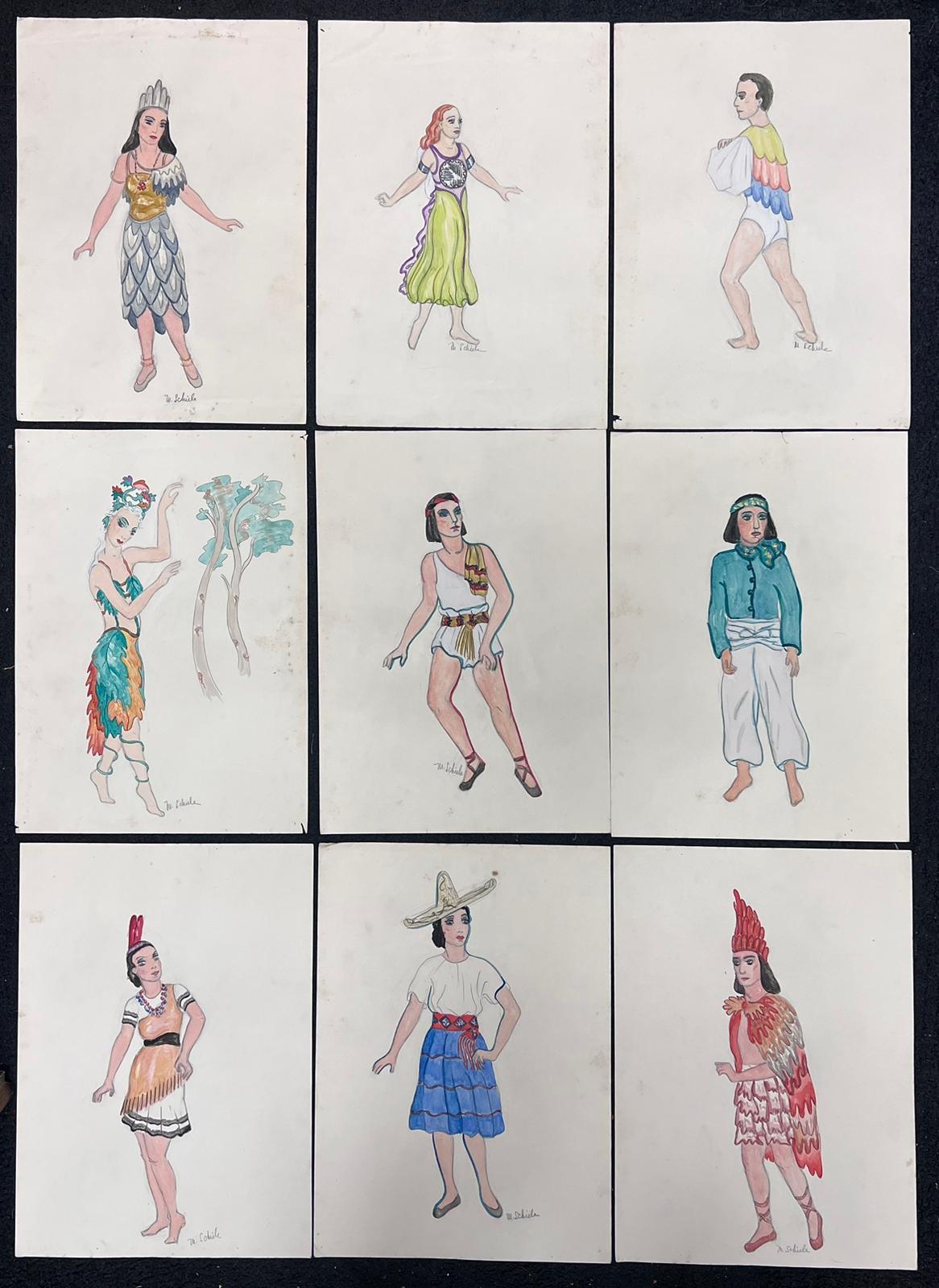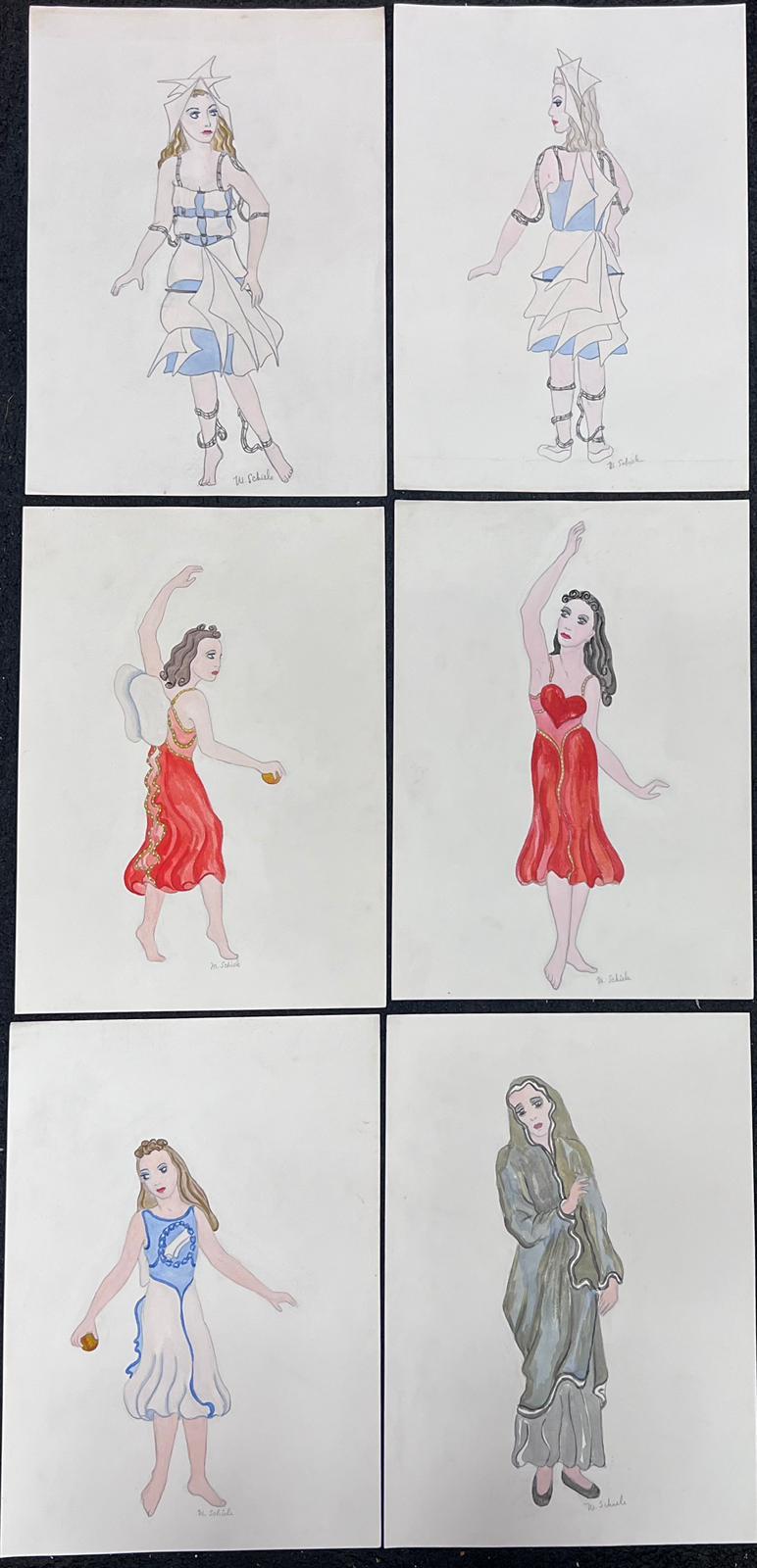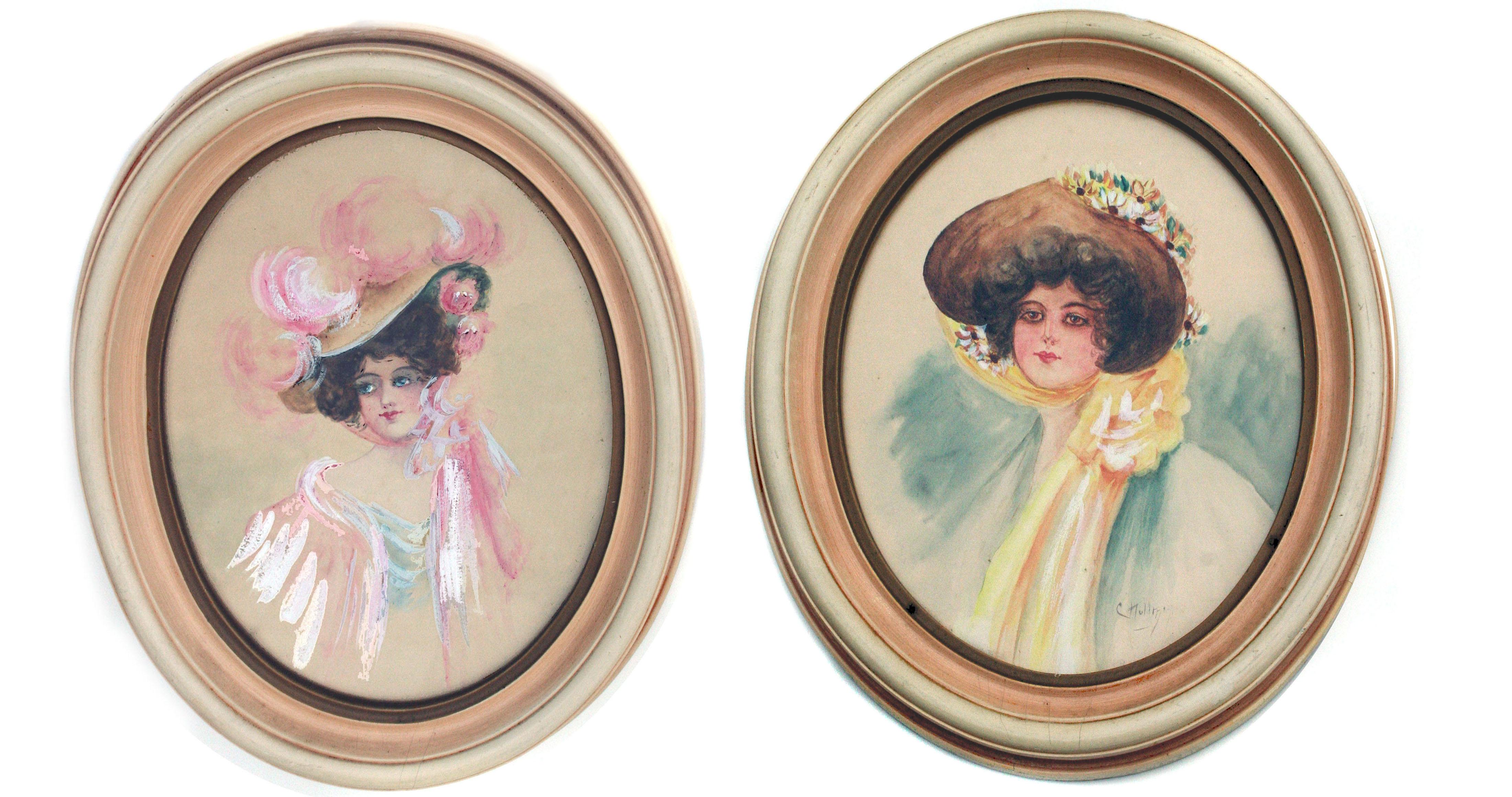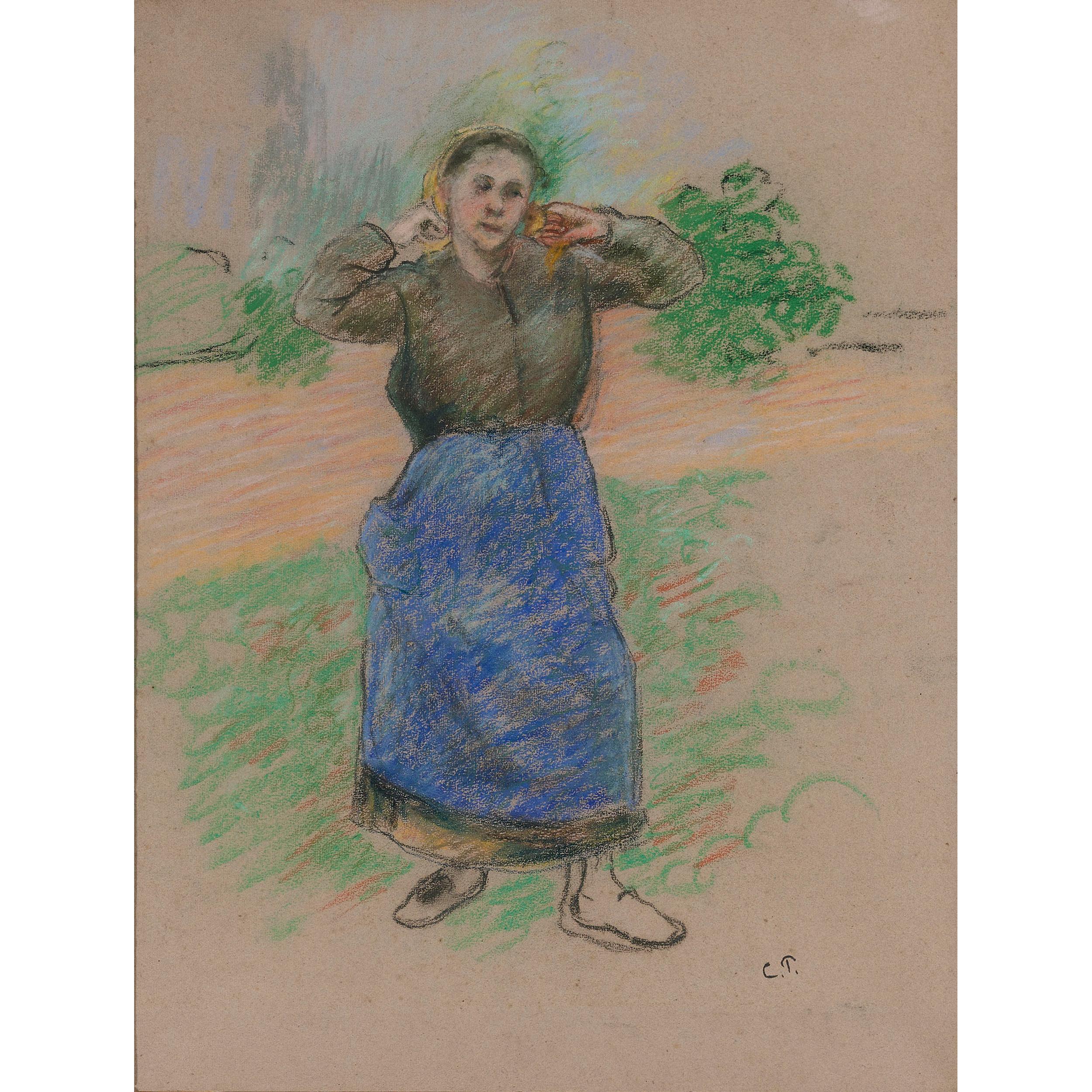Items Similar to Mid 20th Century French Modernist Painting -
Want more images or videos?
Request additional images or videos from the seller
1 of 13
UnknownMid 20th Century French Modernist Painting - c. 1950's
c. 1950's
About the Item
Artist/ School: French School, mid 20th century
Title: Lady in Red
Medium: watercolour on artists paper
Size: painting: 15 x 19.75 inches
Provenance: private collection, France
Condition: The painting is in very good condition.
- Creation Year:c. 1950's
- Dimensions:Height: 15 in (38.1 cm)Width: 19.75 in (50.17 cm)Depth: 1 in (2.54 cm)
- Medium:
- Movement & Style:
- Period:
- Condition:
- Gallery Location:Cirencester, GB
- Reference Number:1stDibs: LU50937402402

About the Seller
5.0
Platinum Seller
These expertly vetted sellers are 1stDibs' most experienced sellers and are rated highest by our customers.
Established in 1989
1stDibs seller since 2016
3,485 sales on 1stDibs
Typical response time: 2 hours
- ShippingRetrieving quote...Ships From: Cirencester, United Kingdom
- Return PolicyA return for this item may be initiated within 3 days of delivery.
More From This SellerView All
- Set of 9 Figure Illustrations Egyptian Classical Characters Listed AmericanLocated in Cirencester, GloucestershireSet of x9 figures original watercolour painting on artist paper signed by Marjorie Schiele (1913-2008) *see notes below piece of paper is 14 x 10 inches In good condition provenance:...Category
Early 20th Century American Impressionist Figurative Paintings
MaterialsWatercolor
- Set of 9 Figure Illustrations Egyptian Classical Characters Listed AmericanLocated in Cirencester, GloucestershireSet of x 9 figures original watercolour painting on artist paper signed by Marjorie Schiele (1913-2008) *see notes below piece of paper is 14 x 10 inches In good condition provenance...Category
Early 20th Century American Impressionist Figurative Paintings
MaterialsWatercolor
- Set of 6 Figure Illustrations Egyptian Classical Characters Listed AmericanLocated in Cirencester, GloucestershireSet of x6 figures original watercolour painting on artist paper signed by Marjorie Schiele (1913-2008) *see notes below piece of paper is 14 x 10 inches In good condition provenance:...Category
Early 20th Century American Impressionist Figurative Paintings
MaterialsWatercolor
- 20th Century French Modernist Cubist Painting Broodin Portrait Dark Haired LadyLocated in Cirencester, GloucestershirePortrait by Paul-Louis Bolot (French 1918-2003) signed (dated 1981) original gouache painting on thick paper/ card unframed condition: very good and sound; the edges have a few curls...Category
20th Century Cubist Figurative Paintings
MaterialsGouache
- 1930's Original Parisian Fashion Watercolor Blue Floral Summer DressLocated in Cirencester, GloucestershireVery stylish, unique and original 1930's French fashion design, no doubt of Parisian origin. The painting, executed in gouache/ watercolor and pencil, is dated to the upper corner ...Category
Mid-20th Century Impressionist Portrait Paintings
MaterialsGouache, Watercolor, Pencil
- 1940's Fashion Illustration - Three Elegant Women Walking Through The ParkLocated in Cirencester, GloucestershireVery stylish, unique and original 1940's fashion design by French illustrator Geneviève Thomas. The painting, executed in gouache and pencil. The sketch is original, vintage and me...Category
Mid-20th Century Impressionist Portrait Paintings
MaterialsGouache
You May Also Like
- Gibson Girls - Set of Two 1920's Portraits, Vintage Fashion IllustrationsLocated in Soquel, CAGorgeous pair of two 1920's watercolor portraits of Gibson girls, one in blue and one in pink, by Charles Hollman (Dutch, 1877-1953). Each portrait renders...Category
1920s American Impressionist Portrait Drawings and Watercolors
MaterialsWatercolor, Paper
- Paysanne Nouant son Foulard (Peasant Arranging her Scarf)By Camille PissarroLocated in New Orleans, LAThis intimate work by Camille Pissarro represents a period of significance for the Impressionist master. The early 1880s was a time of great experimentation for the artist, after he spent much of the preceding decade devoted to landscape painting. Shifting focus, he embarked on a series of works in a range of media dedicated to the human figure - particularly peasant women. In watercolor, gouache, pastel, and print, Pissarro captured the rural female and the minute moments of domestic life. Depicting a peasant woman tying her scarf, Paysanne Nouant son Foulard displays the harmony of color and composition that typifies his work of the 1880s. Composed of a symphony of color and strokes of paint, the work exemplifies the plein air technique of Pissarro's best Impressionist canvases. A true master of his art, no other artist successfully chronicled rural peasant life quite like Pissarro. Counted among the most respected artists of the 19th century and widely considered the father of Impressionism, Pissarro’s works experienced a surge in interest in the early 2000s. This is reflected in Pissarro’s new auction record of over $32.1 million, set at a 2014 Sotheby’s auction in London, which far surpassed his previous record of $14.6 million. Born in St. Thomas in the Danish West Indies, Pissarro was sent to school in Paris at the age of 11, where he first displayed a talent for drawing. In 1855, having convinced his parents of his determination to pursue a career as an artist rather than work in the family shipping business, he returned to Paris where he studied at the Académie Suisse alongside Claude Monet. At the outbreak of the Franco-Prussian War in 1870, Pissarro moved to England. With Monet, he painted a series of landscapes around South-East London and studied English landscape painters in the museums. When he returned home to Louveciennes a year later, Camille discovered that all but 40 of the 1500 paintings he had left there - almost 20 years of work - had been vandalized. In 1872, Camille settled in Pontoise where he remained for the next 10 years, gathering a close circle of friends around him. Gauguin was among the many artists to visit him there and Cézanne, who lived nearby, came for long periods to work and learn. In 1874, Pissarro participated in the first Impressionist exhibition...Category
Late 19th Century Impressionist Portrait Drawings and Watercolors
MaterialsPastel, Paper
- Rare Modernist Hungarian Rabbi Pastel Drawing Gouache Painting Judaica Art DecoBy Hugó ScheiberLocated in Surfside, FLRabbi in the synagogue at prayer wearing tallit and tefillin. Hugó Scheiber (born 29 September 1873 in Budapest – died there 7 March 1950) was a Hungarian modernist painter. Hugo Scheiber was brought from Budapest to Vienna at the age of eight where his father worked as a sign painter for the Prater Theater. At fifteen, he returned with his family to Budapest and began working during the day to help support them and attending painting classes at the School of Design in the evening, where Henrik Papp was one of his teachers. He completed his studies in 1900. His work was at first in a post-Impressionistic style but from 1910 onward showed his increasing interest in German Expressionism and Futurism. This made it of little interest to the conservative Hungarian art establishment. However, in 1915 he met the great Italian avant-gardist Filippo Tommaso Marinetti and the two painters became close friends. Marinetti invited him to join the Futurist Movement. The uniquely modernist style that he developed was, however, closer to German Expressionism than to Futurism and eventually drifted toward an international art deco manner similar to Erté's. In 1919, he and his friend Béla Kádar held an exhibition at the Hevesy Salon in Vienna. It was a great success and at last caused the Budapest Art Museum to acquire some of Scheiber's drawings. Encouraged, Scheiber came back to live in Vienna in 1920. A turning point in Scheiber's career came a year later, when Herwarth Walden, founder of Germany's leading avant-garde periodical, Der Sturm, and of the Sturm Gallery in Berlin, became interested in Scheiber's work. Scheiber moved to Berlin in 1922, and his paintings soon appeared regularly in Walden's magazine and elsewhere. Exhibitions of his work followed in London, Rome, La Paz, and New York. Scheiber's move to Germany coincided with a significant exodus of Hungarian artists to Berlin, including Laszlo Moholy-Nagy and Sandor Bortnyik. There had been a major split in ideology among the Hungarian avant-garde. The Constructivist and leader of the Hungarian avantgarde, Lajos Kassák (painted by Hugó Scheiber in 1930) believed that art should relate to all the needs of contemporary humankind. Thus he refused to compromise the purity of his style to reflect the demands of either the ruling class or socialists and communists. The other camp believed that an artist should be a figurehead for social and political change. The fall out and factions that resulted from this politicisation resulted in most of the Hungarian avant gardists leaving Vienna for Berlin. Hungarian émigrés made up one of the largest minority groups in the German capital and the influx of their painters had a significant effect on Hungarian and international art. Another turning point of Scheiber's career came in 1926, with the New York exhibition of the Société Anonyme, organized by Katherine Dreier. Scheiber and other important avant garde artists from more than twenty-three countries were represented. In 1933, Scheiber was invited by Marinetti to participate in the great meeting of the Futurists held in Rome in late April 1933, Mostra Nazionale d’Arte Futurista where he was received with great enthusiasm. Gradually, the Hungarian artists began to return home, particularly with the rise of Nazism in Germany. Kádar went back from Berlin in about 1932 and Scheiber followed in 1934. He was then at the peak of his powers and had a special flair in depicting café and cabaret life in vivid colors, sturdily abstracted forms and spontaneous brush strokes. Scheiber depicted cosmopolitan modern life using stylized shapes and expressive colors. His preferred subjects were cabaret and street scenes, jazz musicians, flappers, and a series of self-portraits (usually with a cigar). his principal media being gouache and oil. He was a member of the prestigious New Society of Artists (KUT—Képzőművészek Új Társasága)and seems to have weathered Hungary's post–World War II transition to state-communism without difficulty. He continued to be well regarded, eventually even receiving the posthumous honor of having one of his images used for a Russian Soviet postage stamp (see image above). Hugó Scheiber died in Budapest in 1950. Paintings by Hugó Scheiber form part of permanent museum collections in Budapest (Hungarian National Museum), Pecs (Jannus Pannonius Museum), Vienna, New York, Bern and elsewhere. His work has also been shown in many important exhibitions, including: "The Nell Walden Collection," Kunsthaus Zürich (1945) "Collection of the Société Anonyme," Yale University Art Gallery, New Haven, Connecticut (1950) "Hugó Scheiber: A Commemorative Exhibition," Hungarian National Museum, Budapest (1964) "Ungarische Avantgarde," Galleria del Levante, Munich (1971) "Paris-Berlin 1900-1930," Centre Georges Pompidou, Paris (1978) "L’Art en Hongrie, 1905-1920," Musée d’Art et l’Industrie, Saint-Etienne (1980) "Ungarische Avantgarde in der Weimarer Republik," Marburg (1986) "Modernizmus," Eresz & Maklary Gallery, Budapest (2006) "Hugó Scheiber & Béla Kádár," Galerie le Minotaure, Paris and Tel Aviv (2007) Hugó Scheiber's paintings continue to be regularly sold at Sotheby's, Christie's, Gillen's Arts (London), Papillon Gallery (Los Angeles) and other auction houses. He was included in the exhibition The Art Of Modern Hungary 1931 and other exhibitions along with Vilmos Novak Aba, Count Julius Batthyany, Pal Bor, Bela Buky, Denes Csanky, Istvan Csok, Bela Czobel, Peter Di Gabor, Bela Ivanyi Grunwald, Baron Ferenc Hatvany, Lipot Herman, Odon Marffy, C. Pal Molnar...Category
Early 20th Century Modern Figurative Paintings
MaterialsPaper, Charcoal, Pastel, Watercolor, Gouache
- Yogi and Ted - Baseball Greats Yogi Berra and Ted Williams, Watercolor on PaperBy Margie LawrenceLocated in Chicago, ILLawrence Peter "Yogi" Berra was an American professional baseball catcher who later took on the roles of manager and coach. He played 19 seasons in Ma...Category
2010s Contemporary Portrait Drawings and Watercolors
MaterialsWatercolor, Paper
- Ron Santo and Ernie Banks - Original Painting of "Mr. Cub" and "Mr. Sunshine"By Margie LawrenceLocated in Chicago, ILRon Santo was an American Major League Baseball third baseman who played for the Chicago Cubs from 1960 through 1973 and the Chicago White Sox in 1974 Hall of fame induction: 2012 Ernest Banks, nicknamed "Mr. Cub" and "Mr. Sunshine", was an American professional baseball player who starred in Major League Baseball as a shortstop and first baseman for the Chicago Cubs between 1953 and 1971 Hall of fame induction: 1977 This artwork is framed in a simple black frame measuring 24.5 x 28 inches. Margie Lawrence Ron Santo and Ernie Banks...Category
2010s Contemporary Portrait Drawings and Watercolors
MaterialsWatercolor, Acrylic, Paper
- Ernie Banks at Ebetts Field - Chicago Cubs Baseball Great, Watercolor FramedBy Margie LawrenceLocated in Chicago, ILErnie Banks, aka "Mr. Cub" and "Mr. Sunshine", was a professional baseball player who starred in Major League Baseball as a shortstop and first baseman for...Category
2010s Contemporary Portrait Drawings and Watercolors
MaterialsWatercolor, Paper
Recently Viewed
View AllMore Ways To Browse
The Mid Modernist
Mid Century French Artists
Mid Century French Artist
Mid Century Modernist Art
Modernist Painting 20th Century
Mid Century French Modernist
Mid Century Painting Red
French 20th C Paintings
Mid Century Modernist Paintings
French Modernist Paintings
Lady In Red
Mid Century Modernist Paintings And Drawings
Mid Century Portrait Painting Lady
Midcentury Modernist Portrait
Purple Lady
French Watercolor Purple
Oneness Art
Painting In Frame





